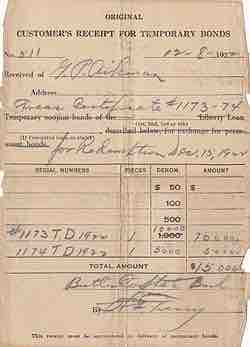Par value/face value (also known as the principal) is the amount of money a holder will get back once a bond matures. Par value means stated value or face value in finance and accounting. From this comes the expressions at par (at the par value), over par (over par value) and under par (under par value).
A newly issued bond usually sells at the par value. Corporate bonds normally have a par value of $1,000, but this amount can be much greater for government bonds. What confuses many people is that the par value is not the price of the bond. A bond's price fluctuates throughout its life in response to a number of variables, including interest rates and time to maturity. When a bond trades at a price above the face value, it is said to be selling at a premium. When a bond sells below face value, it is said to be selling at a discount.

Temporary bonds for the state of Kansas issued in 1922
Par values of these bonds were $50, $100, $10000, and $3000.
Pull to par is the effect in which the price of a bond converges to par value as time passes. At maturity, the price of a debt instrument in good standing should equal its par (or face value). Another name for this effect is "reduction of maturity. " It results from the difference between market interest rate and the nominal yield on the bond.
A bond selling at par has a coupon rate such that the bond is worth an amount equivalent to its original issue value or its value upon redemption at maturity. In other words, if you buy a bond at face value, or par, when it is issued and hold it until it matures, you'll earn interest at the stated, or coupon, rate. For example, if you buy a 20-year $1,000 bond paying $550 a year for 20 years. The yield, or your return on investment, will also be 5%. You will get your $1,000 back when the 20 years are up. You can also buy and sell bonds through a broker after their date of issue. This is known as the "secondary market" or "resale market. "